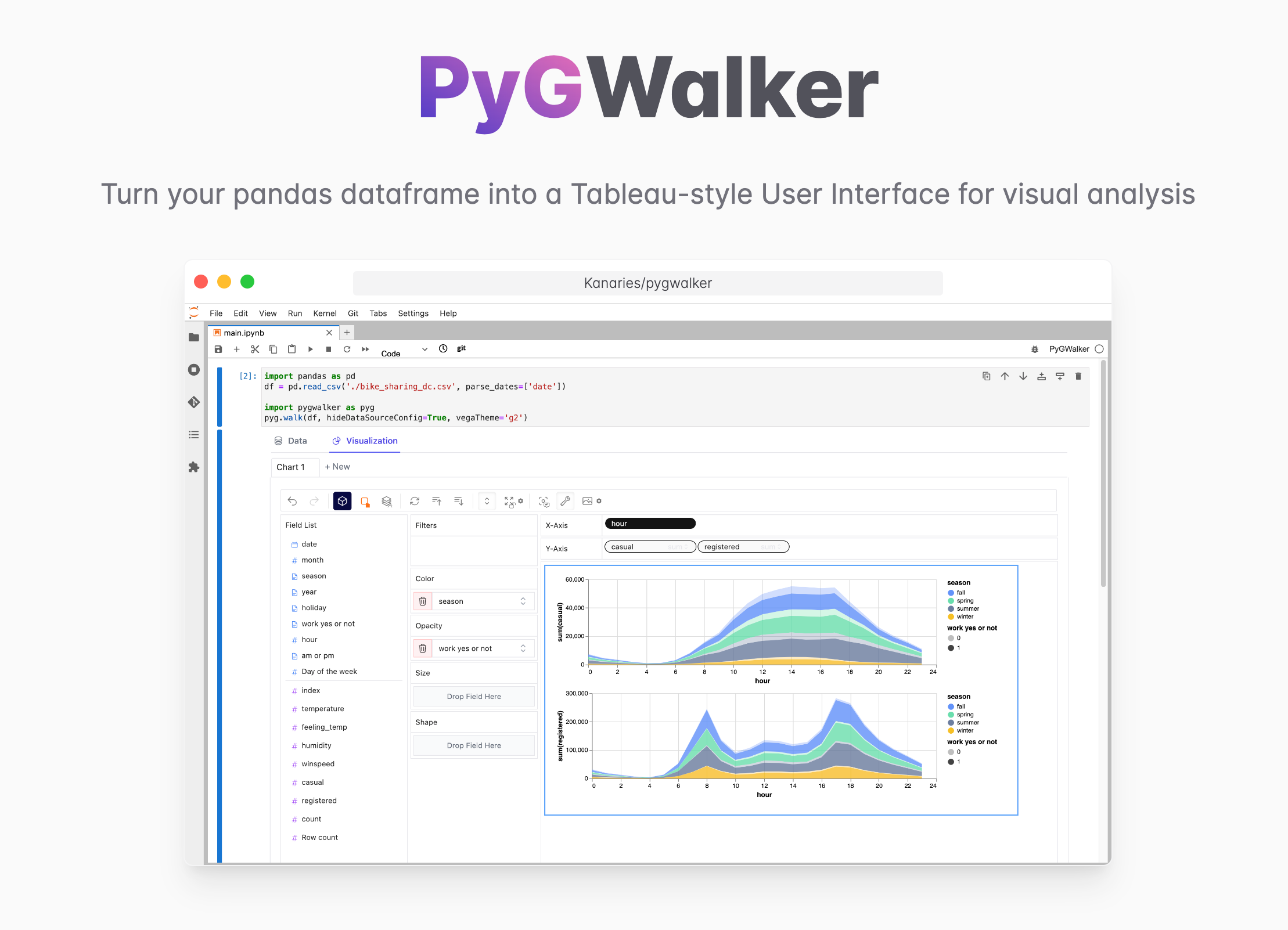Mastering Data Analysis with CatBoost in Python: An In-depth Guide
Updated on
CatBoost, an innovative open-source machine learning library developed by Yandex, has been a game-changer in the realm of data science. With a strong emphasis on handling categorical data and applying gradient boosting techniques, CatBoost in Python offers exceptional performance and impressive functionalities. This article delves deep into the benefits and capabilities of CatBoost and spotlights its flagship feature: the CatBoost Classifier.
Want to quickly create Data Visualization from Python Pandas Dataframe with No code?
PyGWalker is a Python library for Exploratory Data Analysis with Visualization. PyGWalker (opens in a new tab) can simplify your Jupyter Notebook data analysis and data visualization workflow, by turning your pandas dataframe (and polars dataframe) into a tableau-alternative User Interface for visual exploration.
Why Use CatBoost Python?
Choosing the right machine learning library can significantly impact the outcome of your data science projects. The CatBoost Python library stands out for its high-performance capabilities, unique handling of categorical variables, and robust resistance to overfitting. It also eliminates the need for manual preprocessing steps like one-hot encoding, often needed when working with other machine learning libraries.
from catboost import CatBoostClassifier
import pandas as pd
# Load your data
data = pd.read_csv('your_data.csv')
# Initialize CatBoostClassifier
model = CatBoostClassifier(iterations=50, depth=3, learning_rate=0.1, loss_function='Logloss')
# Fit model
model.fit(data)Exploring the Power of CatBoost Classifier
An Overview of CatBoost Classifier
The CatBoost Classifier leverages gradient boosting to address classification problems with discrete class labels as the target variable. It presents a host of advantages, including superior handling of categorical features, minimized overfitting, and more precise, quicker predictions.
Applying CatBoost Classifier in Python: A Practical Example
Consider a scenario where we aim to predict a bank customer's likelihood of defaulting on a loan payment. Here's how the CatBoost Classifier can be applied:
from catboost import CatBoostClassifier
import pandas as pd
from sklearn.model_selection import train_test_split
# Load your data
data = pd.read_csv('loan_data.csv')
# Split data into train and test sets
X_train, X_test, y_train, y_test = train_test_split(data.drop('Loan_Default', axis=1), data['Loan_Default'], test_size=0.2, random_state=42)
# Define categorical features
cat_features = ['Employment_Type', 'Education_Level', 'Marital_Status']
# Initialize CatBoostClassifier
model = CatBoostClassifier(iterations=500, depth=5, learning_rate=0.05, cat_features=cat_features)
# Fit model
model.fit(X_train, y_train, eval_set=(X_test, y_test), plot=True)Deeper Insights into CatBoost's Unique Features
Superior Handling of Categorical Variables
One of CatBoost's main selling points is its unique approach to categorical variables. It applies an efficient encoding scheme called "ordered boosting," which mitigates the prediction shift caused by traditional encoding methods, enhancing prediction accuracy.
Prevention of Overfitting
Overfitting is a common pitfall in machine learning, where a model performs well on training data but fails to generalize to unseen data. CatBoost employs a technique known as "Oblivious Trees," which controls the complexity of the model, mitigating overfitting risks.
Accurate and Speedy Predictions
CatBoost's advanced algorithms provide not only accurate predictions but also rapid computation. It is designed for parallel processing and can fully utilize multiple cores, significantly reducing computation time without compromising accuracy.
Conclusion: CatBoost in Python - A Powerful Tool for Data Science
CatBoost Python and its CatBoost Classifier offer potent solutions to some common challenges in the field of data science. Its superior performance in dealing with categorical data, prevention of overfitting, and enhanced predictive accuracy make it an essential tool in any data scientist's toolkit. Whether you're just starting your journey in data science or you're a seasoned professional, mastering the CatBoost in Python can significantly enhance your data analysis capabilities.
In this article, we have barely scratched the surface of what CatBoost Python can do. The depth and breadth of its functionality are immense, and we recommend further exploring this powerful library.
Remember that as with any tool or technique, understanding the underlying theory and mechanics is crucial to maximizing its potential.
Frequently Asked Questions
-
Is CatBoost better than XGBoost?
The choice between CatBoost and XGBoost depends on the specific task, dataset, and requirements. Both CatBoost and XGBoost are powerful gradient boosting frameworks with their own strengths. CatBoost excels in handling categorical features and missing values, while XGBoost offers extensive hyperparameter tuning options and is widely used in machine learning competitions. It is recommended to evaluate both frameworks on your specific use case to determine which one suits your needs better.
-
What is the best learning rate for CatBoost?
The ideal learning rate for CatBoost depends on the complexity of the problem and the size of the dataset. In general, a learning rate between 0.01 and 0.1 is a good starting point. If the model is underfitting, you can try decreasing the learning rate, and if it's overfitting, you can increase the learning rate. It's important to perform cross-validation and experiment with different learning rates to find the optimal value for your specific task.
-
What is the acronym CatBoost?
The acronym "CatBoost" stands for "Category Boosting." It represents the focus of the CatBoost algorithm on effectively handling categorical features in machine learning tasks. CatBoost incorporates innovative techniques, such as target encoding and combination of statistics from categorical variables, to leverage the information present in categorical features and improve predictive performance.
